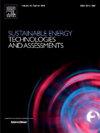评估汽车集成光伏技术:财务和环境视角
IF 7.1
2区 工程技术
Q1 ENERGY & FUELS
Sustainable Energy Technologies and Assessments
Pub Date : 2024-10-21
DOI:10.1016/j.seta.2024.104042
引用次数: 0
摘要
将光伏(PV)技术集成到电动汽车(EV)中,可以提高汽车的能源效率,从而有望成为一种环保的交通解决方案。另一方面,由于车辆的集成面积有限,光伏发电的功率输出相对较低。在这种情况下,人们开始从不同角度讨论光伏-电动汽车集成解决方案的合理性。本研究旨在利用制造商提供的市场上太阳能辅助电动汽车的数据,对光伏-电动汽车集成进行现实评估。评估分为三类:基于投资回收期的财务评估、基于碳排放的环境评估和基于充电依赖性的使用评估。研究结果表明,集成到当代太阳能辅助市场车辆中的光伏系统可在 8.7 年内获得投资回报。从环保角度来看,混合动力汽车的碳排放量最多可减少 12%,而全电动汽车的碳排放量最多可减少 32.5%。基于使用情况的评估显示,光伏-电动汽车一体化对于日常出行距离较短的国家尤为有利。根据评估结果,在车辆中使用光伏电池板有可能将无需充电的使用时间延长多达 170%。本文章由计算机程序翻译,如有差异,请以英文原文为准。
Assessment of Vehicle-Integrated Photovoltaics: A financial and environmental perspective
Integrating photovoltaic (PV) technology into electric vehicles (EVs) promises an environmentally friendly transportation solution by increasing the energy efficiency of vehicles. On the other hand, the limited integration area of the vehicle causes PVs to have relatively lower power output. This situation creates a discussion about how reasonable a solution for PV-EV integration is from various perspectives. This study aims to provide a realistic assessment of PV-EV integration using manufacturer-provided data on solar-assisted EVs in the market. Assessments are examined in three categories: financial assessment based on payback period, environmental assessment based on carbon emissions, and usage-based assessment based on charging dependency. The findings indicate that the PV systems integrated into contemporary solar-assisted market vehicles demonstrate a return on investment within 8.7 years. From an environmental perspective, hybrid vehicles can provide up to a 12 % reduction in carbon emissions, while fully EVs can achieve reductions of up to 32.5 %. Usage-based assessments showed that PV-EV integration is especially advantageous for countries with low daily travel distances. According to the assessment, the use of PV panels in vehicles can potentially extend the usage time without recharging by up to 170 %.
求助全文
通过发布文献求助,成功后即可免费获取论文全文。
去求助
来源期刊

Sustainable Energy Technologies and Assessments
Energy-Renewable Energy, Sustainability and the Environment
CiteScore
12.70
自引率
12.50%
发文量
1091
期刊介绍:
Encouraging a transition to a sustainable energy future is imperative for our world. Technologies that enable this shift in various sectors like transportation, heating, and power systems are of utmost importance. Sustainable Energy Technologies and Assessments welcomes papers focusing on a range of aspects and levels of technological advancements in energy generation and utilization. The aim is to reduce the negative environmental impact associated with energy production and consumption, spanning from laboratory experiments to real-world applications in the commercial sector.
 求助内容:
求助内容: 应助结果提醒方式:
应助结果提醒方式:


